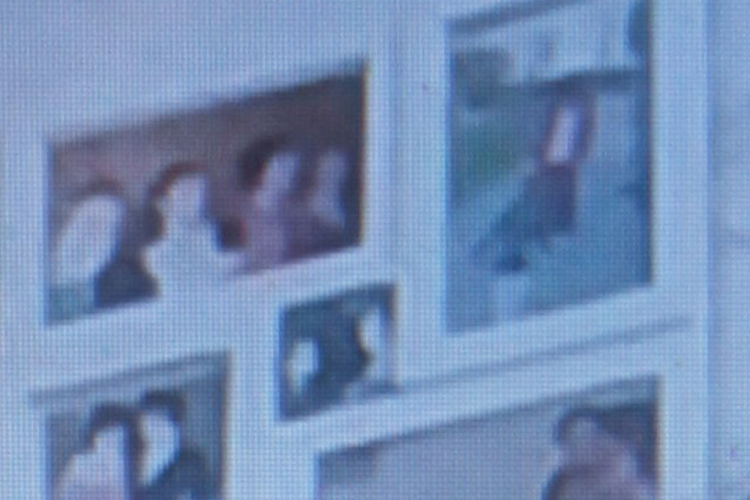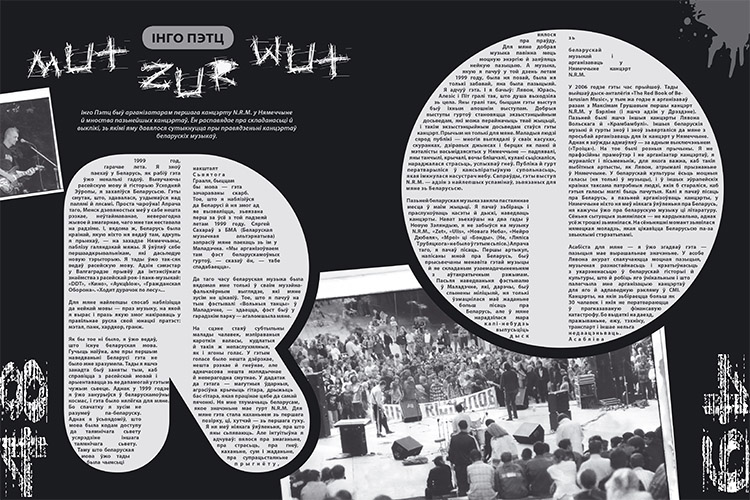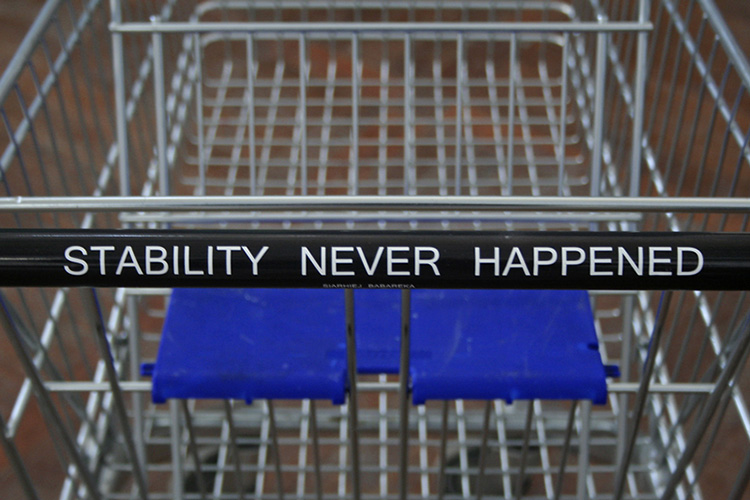
Аўтар: Volha Bubić, 04/11/2015 | ART Cult Aktivist project
APPROPRIATING PHOTOGRAPHY: IN SEARCH FOR THE AUTHOR
The history of the appropriation strategy in art and literature dates back to more than a century, but its use in the field of photography has not become everyday practice yet and from time to time opens up new debates.
Artists appropriate or, in other words, borrow any artifacts of the real world: from objects to existing pieces of art. Contemporary photographers perceive the archive of printed and virtual images constantly growing in an uncontrollable way as a source of inspiration and a material of reconstruction. The authors from our region also do not stand aside from rethinking the results of other people’s visual experience.
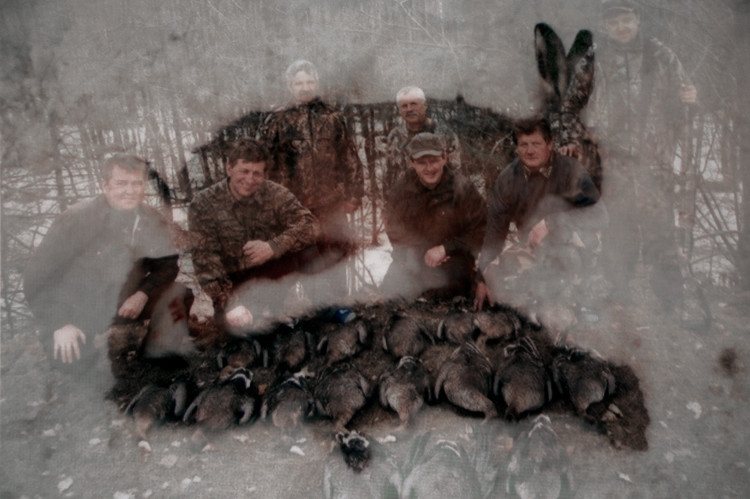
Maxim Sarychau, from the series «Hello to Arms!»
In the essay «Death of the Author» (1967) the French philosopher Roland Barthes exposing the authority and authorship of artists and writers asserts that any text is something much larger than a mere sequence of words that possess a single meaning. This is «a multi-dimensional space in which a variety of writings, none of them original, blend and class. The text is a tissue of quotations drawn from the innumerable centre of culture». In the theory of discourse analysis the understanding of a text is far from being limited to its representation in the form of «a paper medium», so Barthes’ thesis can be easily applicable to the visual field. Any photograph is not only a fragment of the captured reality, its borders extend beyond the situation of here and now. No image in itself is new or unique: each is a re-thought cocktail of meanings, hidden in the culturally and historically shaped signs and symbols.
Indeed, for more than one decade artists have been sticking to the opinion that in fact the originality does not exist. Already at the beginning of the previous century avant-garde artists boldly appropriated various materials from mass media and advertising combining them by means of the techniques of collage that became really popular in the course of time. The authors from Pablo Picasso and Alexander Rodchenko to Barbara Kruger experimented with typography and unusual poster inserts, replacing the conventional meanings with a number of new interpretations of their own. In fact, it is this simple mechanism which underlies any appropriation: borrowing already existing material, the artist performs certain manipulations, either mechanical and conceptual, thereby placing the original object or image into a new, more meaningful and topical context and thus creating a new piece of art. Thus, the artist’s contribution lies in the re-contextualization of the borrowed material, in adding a kind of superstructure to the original author’s idea.
Today’s artists do not get tired to create a variety of original forms of processing other artists’ works. Collages acquire several dimensions, they go out of the frame and turn into museum installations.
Not only images, but also much more subtle things become subjected to appropriation. For example, Lalla Essaydi, a photographer from Morocco, combines the reconstruction of recognizable scenes from French paintings of the XIX century with traditional henna calligraphy, which she applies to the surface of images covering faces, hands and feet of her models, as well as their clothes and fabrics. The image of women in Western culture transmitted by the borrowed postures is reinterpreted by Lalla through the filter of her native, Eastern culture — conceptual layers are fused into a philosophical statement about the nature of beauty and femininity in the two somehow opposite cultures.

Lalla Essaydi, «Harem №2»
However, appropriation not always can be as subtle as that used by the Arabian artist. In today’s world of the amateur photography overabundance publicly available on the net, the virtual archive simply can not go unnoticed. One of the remarkable appropriation examples which at the same time remarkably irritates some conservative minds is a long-term project made by the American conceptual artist, Penelope Umbrico. The photographer started working on her series «Suns from Flickr» in 2006, when once having searched by the keyword «sunsets» she was given no less than 541 795 images. The sun turned out to be the most popular topic for amateur photo documentation on this site. And it was this topic that Penelope decided to appropriate: with her «Kodak» camera she reshot fragments with the sun each image contained. It is noteworthy that the project does not yet have a final form: the American artist enriches every new installation with recent images, and the constantly changing name speaks for itself. The number used in the project’s name rose from 541,795 (in 2006) to 5,911,253 (in 2009). The act of appropriation in the case of strangers’ suns was in retaking and cropping the original image whereas the constantly updated conceptual statement can be reduced to a mild irony in relation to the mass romantics obsessed with sunset photographing.
But not every appropriation in contemporary photography looks so harmless.
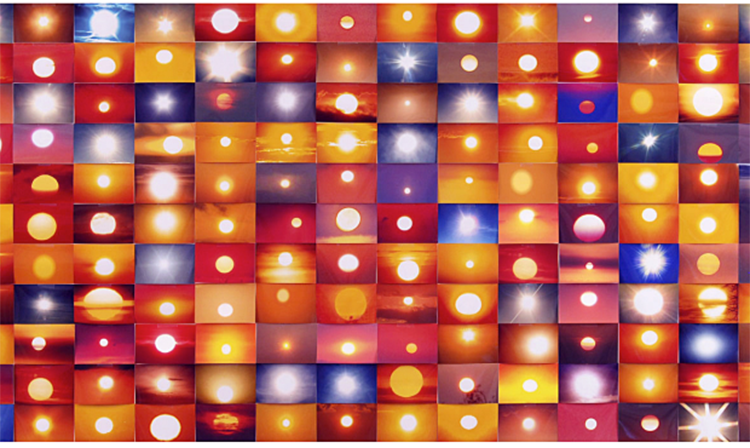
A fragment from the project «Suns from Flickr», by Penelope Umbrico
The trial, which followed the artist Richard Prince’s appropriation and conceptualization of Patrick Cariou’s several dozen photos of Jamaican Rastafarians became widely known. Angered photographer took the case in court, but lost the case. On April 25, 2013 the decision was made in favor of the legitimacy of the strategy of appropriation in contemporary art.
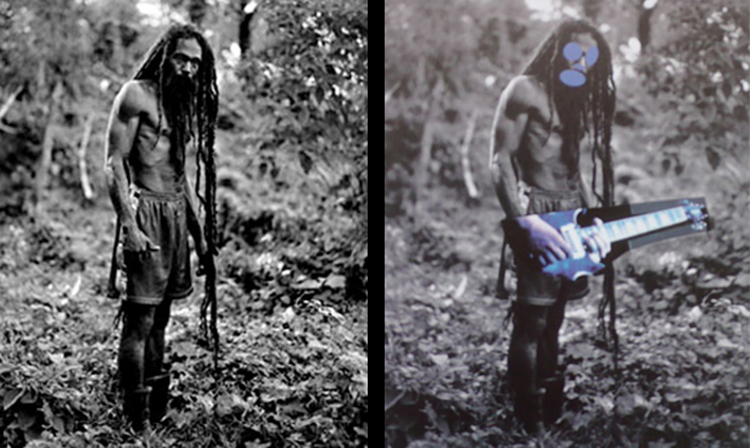
(Left) A photograph from the book «Yes Rasta» Patrick Cariou (Right) A piece of art from the series «Canal Zone» Richard Prince
But if processing other people’s photos is a strategy foreign photographers started to use a long time ago (it is enough, for example, to mention Irina Werning, Joaschim Schmid, Binh Danh, Zoe Leonard, Thomas Hirschhorn), in this region projects where someone else’s visual experience would be conceptualized are not yet so numerous. As examples of Russian photographers dealing with archives we can recall the names of Julia Borissova, Natalya Reznik and Anastasia Bogomolova. An excellent recent example is also the exhibition «Common Imaginary» held in the summer of 2015 by the St. Petersburg institution «FotoDepartament». The exhibition presented projects and installations made by 11 young authors whose research field embraced appropriation of other people’s images posted on the online service AVITO. The curator of the exhibition Nadya Sheremetova refers to the contact of the young photographers and anonymous authors of the online photo archive available at the resource that deals with purchasing and selling of goods and services «a meeting» and «a mutual spellbound». In the text that accompanied the exhibition she explained: «Captured by this redundancy space available to the gaze, the space which goes beyond individual abilities of perception and acceptance, the space of others — neighbors, strangers, anonymous people, the world of objects and desires — the authors launch a game, the seriousness of which is difficult to imagine. It deals with self-identification by means of the other».
Each of the authors in their own way defines both the material for appropriation and the way of interaction with the «original». The topics that as a result of reflection and masks being tried on, were handled by the young photographers embraced the whole range of nuances of the collectively formed aesthetics and cultural identity of the Russians. The most intriguing messages can be discerned in the projects of Olga Sukhareva «To Keep Forever», Nina Dudoladova «To Live through the Place» and Feodora Caplan «Not-in-Itself-Thing».
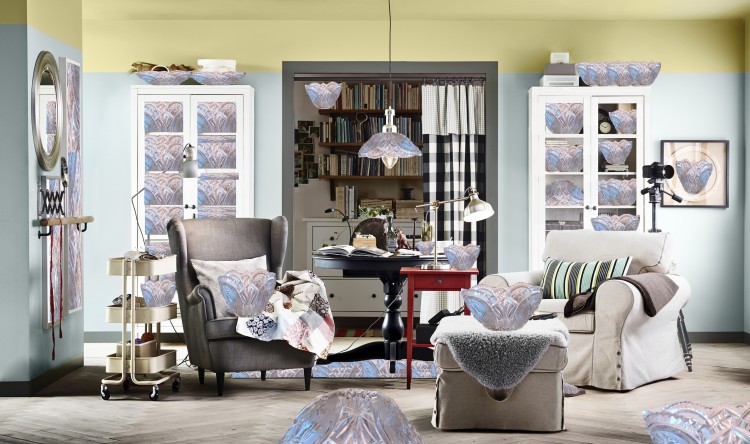
In Оlga Sukhareva’s project «To Keep Forever» the author adds her own interpretation to such a traditionally symbolic value of the Soviet times as crystal. She uses the technique of appropriation, substitution and hyperbole and tries to find the answer to the question: how will the Soviet symbols that once seemed to be lasting forever fit today’s interiors?
Such famous Belarusian photographers as Igor Savchenko, Galina Moskaleva and Vladimir Shakhlevich used the strategy of appropriation already in the 1990s. Contemporary Belarusian authors Andrei Liankevich, Alena Pratasevich, Alexey Naumchik, Maxim Sarychau and Volha Savich also turn to appropriation.
In 2014 Volha Savich’s project «Gene.BY» became a finalist of the «PRAFOTA» contest in the nomination «аrt photography» and shown at the exhibition held within «The Month of Photography in Minsk». Like the authors from St. Petersburg «FotoDepartament» Volha appropriates the images taken from the Internet site that people use for purchasing and selling second-hand goods. Without performing any manipulations with the format and framing of the «оriginal» photos, Volha combines them with the images of symbols considered to be sacral for the Belarusian culture, thus creating something she defines as «a sense puzzle made of two archives». When working on her series Volha Savich applies the technique of «paper transfer print» — a lithographic printing method with the use of gum arabic and black and white paper images that form the basis for the pigment application. As a result, the audience gets in touch with strange timeless mosaics that force them to rethink the notions of the past and present referring to those who in the project description the photographer carefully introduces as the locals.
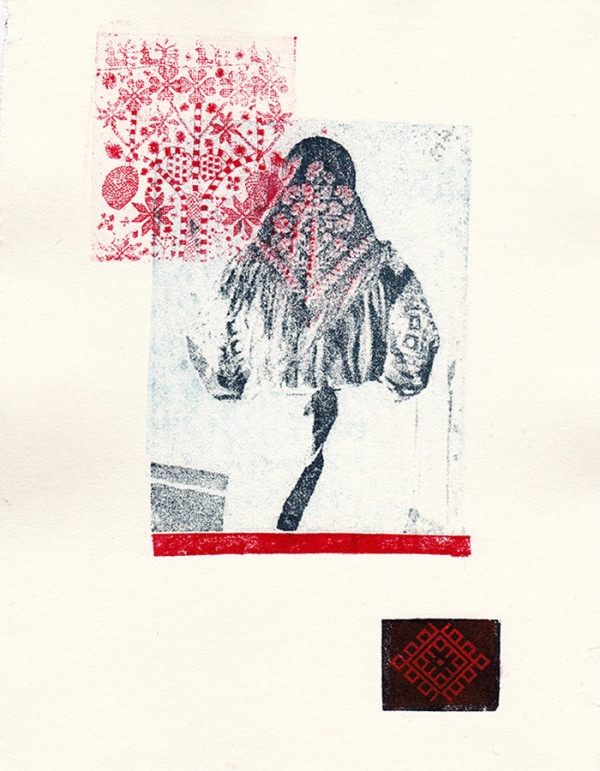
Volha Savich’s images from the series «Gene.BY»
The relationship between humans and animals became the topic of the series «Hello to Arms!» by Maxim Sarychau which the photographer analyzed at the example of the situation of sport hunting. Maxim Sarychau approached this kind of human activity very critically calling it barbaric and sticking to the opinion that the only justification for the killing of animals in hunting is the necessity to get food. He did try to take part in hunting personally as a participant observer, being only armed with his camera, but after that Maxim realized that it would be more fair for the audience and hunters themselves to distance from this process, eliminate the element of subjectivity and work with photographs taken by the hunters.
«Today, with the insane amounts of visual material, before you go and produce new visual garbage, it would be better to think twice. As a photographer, I always ask myself: why am I taking my camera, what new things will I say? Sometimes it is better to borrow images that have already been made before and somehow recycle them,» — the author of «Hello to Arms!» comments. «In my project I took photos made and put on social networks, Flickr and hunting communities by hunters themselves. Then I projected the images on the wall and re-shot them in the multiple exposure mode. As a result of such processing I got a pure self-representation of the hunter, without my intervention or assessment. My author’s position is shown only in a gesture of visual combination of the hunter and his victims. In this case, the method of appropriation is really „appropriate“ and works perfectly well».
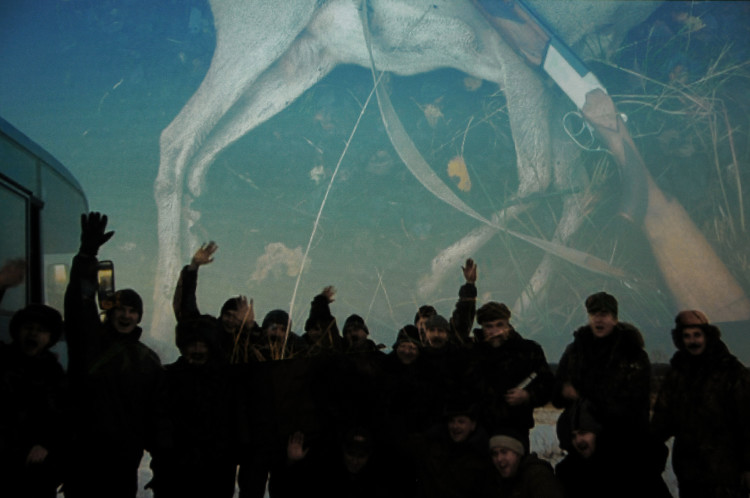
Maxim Sarychau, from the series «Hello to Arms!»
A further story of the project «Hello to Arms!» is related to its appearance among the winners of the prize «Golden Camera 2012». Originally the series was to be awarded with the Grand Prix, however, as it turned out a few days before the ceremony, the jury did not understand that the series had been made through the use of the appropriation strategy. Having found that the photos had not been physically shot by the author, the jury decided to award another project with the Grand Prix, despite the fact that «Hello to Arms!» was submitted as a conceptual, not a documentary project. Maxim even provides the exact wording given by the jury, who commented on their decision saying: «The conclusion of the jury is this: the photographic side of the project is much stronger than its conceptual component. If all of the work had been performed by you, it would 100% be a Grand Prix».
Such a gesture on the part of the seemingly professional people only makes it evident that while photographers and artists have come to a broader and flexible understanding of the medium of photography, those who take on the role of experts and judges are still stuck in nostalgia about a classical reportage and are afraid to see and accept the new tendencies.
Although at the same time it would seem … that what we call «new» became so perfectly and firmly rooted in art already a hundred years ago … Appropriation really turns to be a more than topical way of handling images, a logical and correct method in the conditions of visual avalanche of images and meanings blurring. The philosophy and art of «appropriation» raise questions of originality and authorship, nicely fitting into the postmodern paradigm, where the question of who was the first may only cause a light smile.
Volha Bubič
Opinions of authors do not always reflect the views of pARTisan. If you note any errors, please contact us right away.



